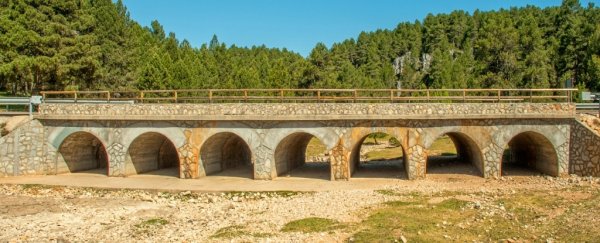Scientists are studying a major, once-in-a-century drought from Medieval Europe to better understand how extreme weather events indicate rapid climate changes.
In the years leading up to the Little Ice Age, between 1302 and 1307, many regions on the European continent were facing exceptional heat and drought, according to historical records and data collected from tree rings and sediment cores.
These extreme natural events, while not driven by human emissions, hold similar characteristics to recent weather anomalies, and they could help us better predict the course of modern-day climate change.
During the early 14th century, north and south regions all over Medieval Europe appear to have see-sawed between extreme rainfall and extreme drought.
This is not unlike what happened to Europe in 2018, when a so-called 'precipitation seesaw' tipped weather anomalies in the north and south to similar extremes.
It's still unclear how similar these two see-saws were, but both appear to have been driven by a gradient of atmospheric pressure. The 2018 drought was marked by low-pressure anomalies over northern and southern Europe, and in the early 1300s, a high-pressure system predominated over central Europe.
"Even if it was a phase of cooling in the Middle Ages and we are now living in a phase of [hu]man-made warming, there could be parallels," says Patric Seifert, a tropospheric researcher at the Leibniz Institute in Germany.
"The transitional period between two climate phases could be characterized by smaller temperature differences between the latitudes and cause longer-lasting large-scale weather patterns, which could explain an increase in extreme events."
Beginning in 1310, the European continent seems to have undergone a rapid shift in climatic conditions, from a period of warming to a period of cooling, marked by extreme wetness.
In fact, some suspect the famous Italian author Dante Alighieri based his descriptions of hell's Inferno on the widespread famine and disease that soon followed.
This period has therefore become known as the "Dantean Anomaly" – a well-researched topic due to its enormous impact on famine and disease in Europe. But researchers now think the years leading up to the Dantean Anomaly were also streaked with extreme weather.
Yet instead of near-constant rain, the first decade of the 14th century appears to have been unusually dry. In 1302, central Europe was still very rainy, and yet in the years to follow, the weather began to change.
Between 1302 and 1304, a new analysis of historical and climate data found the Mediterranean was besieged by a multi-seasonal drought that went on for almost two years.
By 1304, however, this weather seesaw began to tip, creating "a stark contrast between extremely high precipitation in one part of Europe and extremely low precipitation in another".
A series of hot and dry summers, which lasted for another two years, soon gripped the Alps to the north, while Italy and other locations on the Mediterranean went back to receiving an unusual amount of rain.
Even the Middle East reported severe droughts during this time.
"Water levels in the Nile, for example, were exceptionally low," says Thomas Labbé, also from the Leipzig Institute.
"We therefore think that the 1304-06 drought was not only a regional phenomenon, but probably had transcontinental dimensions."
In fact, the team thinks this "outstanding dry anomaly" was part of the natural climatic shift from the Medieval Climate Anomaly to the Little Ice Age. Historians, however, tend to overlook this time in favour of the wetter and more catastrophic Dantean Anomaly.
As such, very little academic attention has been paid to this extreme drought, despite the fact that proxy data from the Aegean basin suggests 1302 to 1304 contained the five driest periods in both the 13th and 14th centuries.
Historical data and contemporary analysis suggest this drought was tied to an increase in fires, lagging behind the climatic phenomenon by about a year. In the summer of 1304, for instance, at the close of Italy's two-year-long drought, a fire burned 1,700 homes in Florence.
A year after the 2018 drought that gripped Europe, various parts of the continent were ravaged by fires.
"While climate fluctuations in the 14th century were natural phenomena, in the modern age, humans are exerting artificial influence on the climate, as well," note Seifert and Martin Bauch, another author on the paper.
What happened to the weather seven centuries ago may not happen in the same way now, but it's important to know if similar mechanisms are at play. Such knowledge could help us predict what extreme weather events are headed our way next.
The study was published in Climate of the Past.
